A) cyclone,southern hemisphere.
B) anticyclone,northern hemisphere.
C) cyclone,northern hemisphere.
D) anticyclone,southern hemisphere.
Correct Answer

verified
Correct Answer
verified
Multiple Choice
More and more wind deflection occurs with height because
A) friction increases with height and deflection by the Coriolis Effect decreases with wind speed.
B) friction decreases with height and deflection by the Coriolis Effect decreases with wind speed.
C) friction increases with height and deflection by the Coriolis Effect increases with wind speed.
D) friction decreases with height and deflection by the Coriolis Effect increases with wind speed.
Correct Answer

verified
Correct Answer
verified
Multiple Choice
How did the zone of cloud cover over the equatorial parts of the Atlantic Ocean change from January to July?
A) It progressively disappeared
B) It shifted to the south
C) It shifted to the north
D) It did not change in position or strength
Correct Answer

verified
Correct Answer
verified
Multiple Choice
Which scenario would create the greatest deflection for a wind by the Coriolis effect?
A) High latitude,accelerating,fast moving wind
B) High latitude,accelerating,slow moving wind
C) Low latitude,decelerating,slow moving wind
D) Low latitude,decelerating,fast moving wind
Correct Answer

verified
Correct Answer
verified
Multiple Choice
Dynamic forcing of upper air currents will create 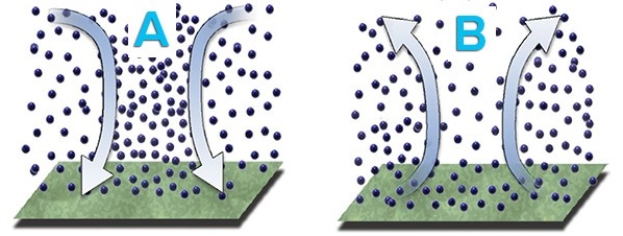
A) upper air convergence at A that results in surface high pressure.
B) upper air divergence at A that results in surface high pressure.
C) upper air convergence at B that results in surface low pressure.
D) upper air convergence at B that results in surface high pressure.
Correct Answer

verified
Correct Answer
verified
Multiple Choice
Where are low pressure cells especially well developed in January?
A) Hawaii
B) Siberia
C) Aleutian Islands
D) Azores
Correct Answer

verified
Correct Answer
verified
Multiple Choice
Why did early sailing ships bringing goods from the Americas to Europe first sail up the eastern coast before crossing the Atlantic Ocean?
A) They were avoiding pirates
B) They wanted to take advantage of the mid-latitude westerlies
C) They needed to stop for fuel only held in northern ports
D) They wanted to avoid the trade winds
Correct Answer

verified
Correct Answer
verified
Multiple Choice
Urban areas heat up more rapidly than surrounding countryside.This can result in
A) low pressure over urban areas with polluted air flowing at the ground surface and then the polluted air sinking over the surrounding countryside.
B) high pressure over urban areas with polluted air flowing at the ground surface and then the polluted air rising over the surrounding countryside.
C) low pressure over urban areas with polluted air flowing aloft and then the polluted air sinking over the surrounding countryside.
D) high pressure over urban areas with polluted air flowing aloft and then the polluted air rising over the surrounding countryside.
Correct Answer

verified
Correct Answer
verified
Multiple Choice
A strong trough in a Rossby wave occurs when the jet stream
A) bends away from the poles.
B) bends toward the poles.
C) does not bend but maintains an east to west flow.
D) does not bend but maintains a west to east flow.
Correct Answer

verified
Correct Answer
verified
Multiple Choice
Which wind belt is located at letter B? 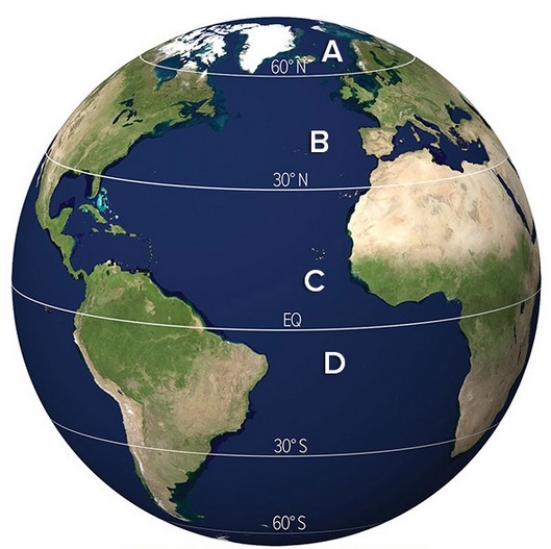
A) Westerlies
B) Polar Easterlies
C) Northeast Trade Winds
D) Southeast Trade Winds
Correct Answer

verified
Correct Answer
verified
Multiple Choice
All of the following are true regarding the monsoon in India and Southeast Asia except it
A) creates a winter dry season.
B) appears in art,music,and architecture.
C) begins in the north and moves south.
D) greens out vegetation in the summer.
Correct Answer

verified
Correct Answer
verified
Multiple Choice
Which of the following best describes the low pressure cell centered for most of the year over the equator?
A) Consistent insolation,varying temperatures,variable rainfall
B) Consistent insolation,warm temperatures,abundant rainfall
C) Variable insolation,warm temperatures,abundant rainfall
D) Variable insolation,warm temperatures,variable rainfall
Correct Answer

verified
Correct Answer
verified
Multiple Choice
Which of the following best represents the geostrophic wind in the northern hemisphere? 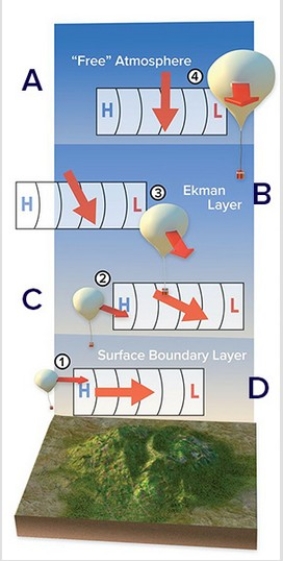
A) A
B) B
C) C
D) D
Correct Answer

verified
Correct Answer
verified
Multiple Choice
Which region had the least amount of clouds?
A) The subtropical parts of northern Africa,especially during January
B) The equatorial part of Africa,especially during January
C) The equatorial parts of South America
D) The equatorial parts of the Atlantic Ocean
Correct Answer

verified
Correct Answer
verified
Multiple Choice
A true difference between north and south polar areas is
A) North Pole is over ocean,while South Pole is over land.
B) high pressure is located over North Pole,while low pressure is over South Pole.
C) low pressure located over North Pole,while high pressure is over South Pole.
D) South Pole is over ocean,while North Pole is over land.
Correct Answer

verified
Correct Answer
verified
Multiple Choice
Which of the following locations experiences the largest continuous belt of strong low pressure? 
A) A
B) B
C) C
D) D
Correct Answer

verified
Correct Answer
verified
Multiple Choice
Which represents the proper pressure cell arrangement for the Hadley Cell? 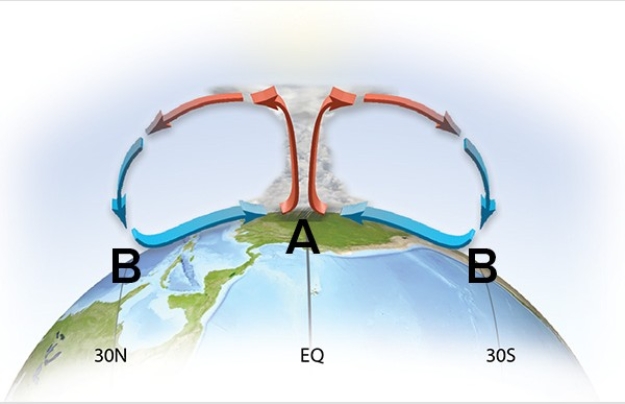
A) Low pressure at A,high pressure at B
B) High pressure at A,low pressure at B
C) High pressure at A,high pressure at B
D) Low pressure at A,low pressure at B
Correct Answer

verified
Correct Answer
verified
Multiple Choice
This diagram features a 
A) cyclone,southern hemisphere.
B) anticyclone,northern hemisphere.
C) cyclone,northern hemisphere.
D) anticyclone,southern hemisphere.
Correct Answer

verified
Correct Answer
verified
Multiple Choice
Based on your knowledge of the pressure gradient and Coriolis effect,identify the proper pressure cell and location. 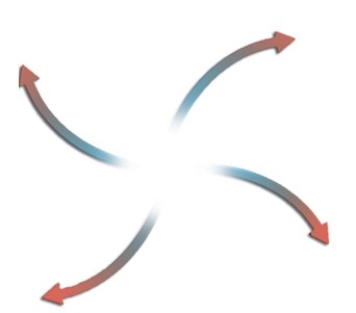
A) Low pressure,Northern Hemisphere
B) Low pressure,Southern Hemisphere
C) High pressure,Southern Hemisphere
D) High pressure,Northern Hemisphere
Correct Answer

verified
Correct Answer
verified
Multiple Choice
The Hadley cell is characterized by.
A) low pressure,sinking air over the equator; high pressure,rising air at 30°N and 30°S.
B) high pressure,sinking air over the equator; low pressure,rising air at 30°N and 30°S.
C) low pressure,rising air over the equator; high pressure,sinking air at 30°N and 30°S.
D) high pressure,rising air over the equator; low pressure,sinking air at 30°N and 30°S.
Correct Answer

verified
Correct Answer
verified
Showing 61 - 80 of 81
Related Exams